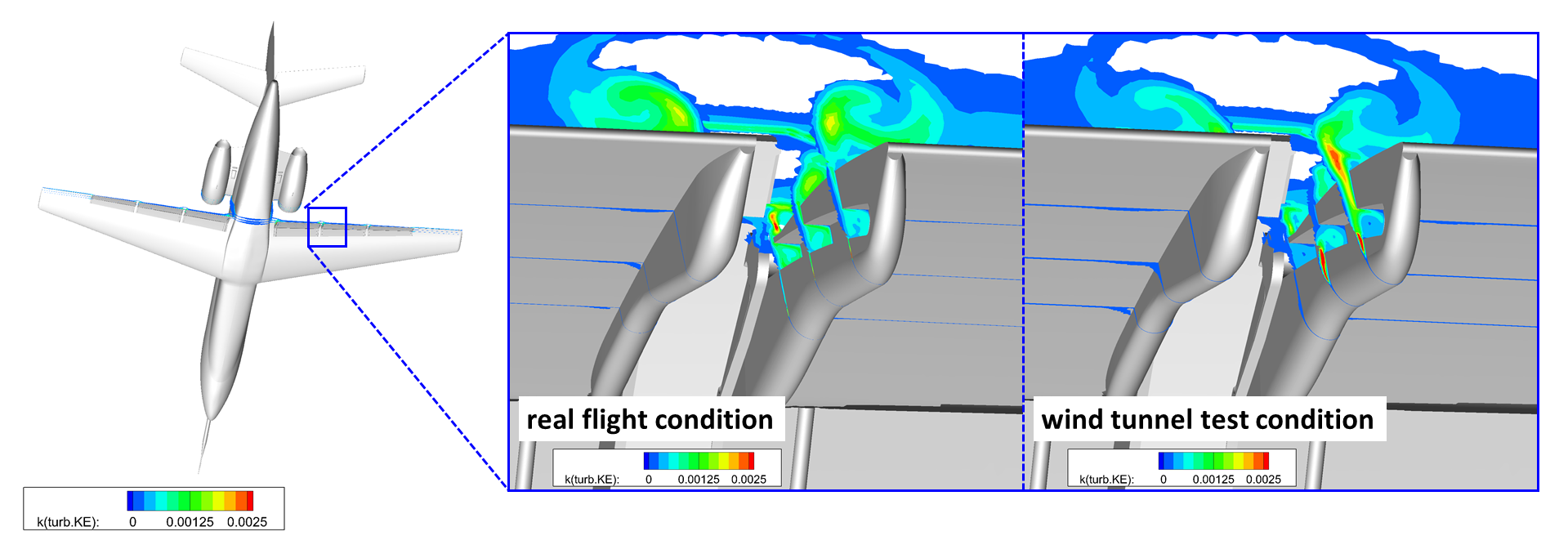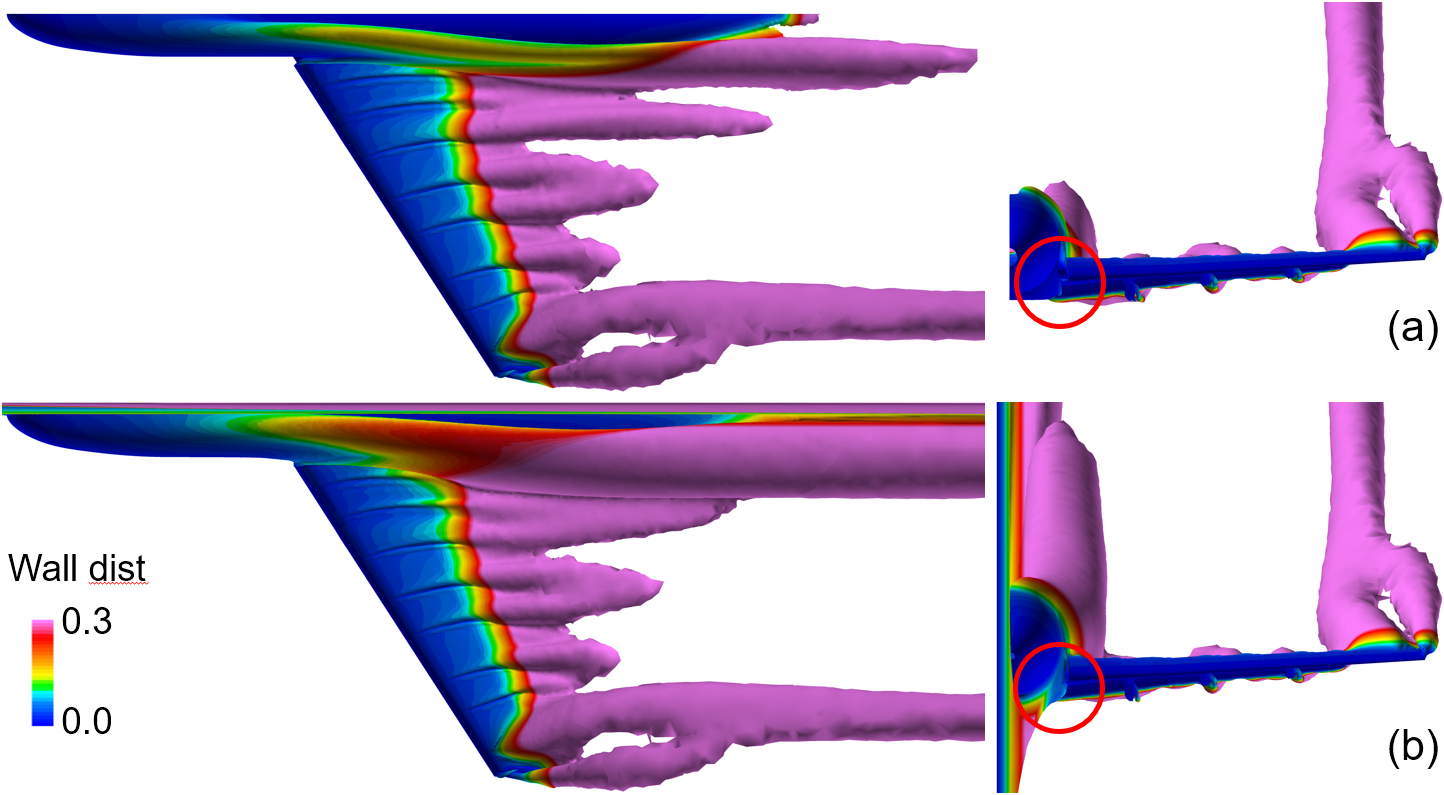Computational Simulations for Aircraft Modification Design in the FQUROH Project
JAXA Supercomputer System Annual Report April 2018-March 2019
Report Number: R18EA2800
Subject Category: Aeronautical Technology
- Responsible Representative: Kazuomi Yamamoto, FQUROH Project Team, Aeronautical Technology Directorate
- Contact Information: Kazuomi Yamamoto(yamamoto.kazuomi@jaxa.jp)
- Members: Kazuomi Yamamoto, Yasushi Ito, Takehisa Takaishi, Mitsuhiro Murayama, Ryotaro Sakai, Tohru Hirai, Kentaro Tanaka, Kazuhisa Amemiya, Gen Nakano, Takashi Ishida
Abstract
The FQUROH project aims at raising the technical maturity level of the noise reduction technology for high-lift devices and landing gear, which draws international attention to reduce noise in areas around airports, to a level applicable to future development of aircraft and related equipment. This contributes to reduction of aircraft noise in local communities around the airport and airline operating costs by reducing landing fee. One of the objectives of the FQUROH project is to verify the feasibility of practical noise reduction concepts and design methods based on advanced computational simulations through modification of aircraft. Computational simulations were performed as part of the FQUROH project to understand Reynolds number effects resulting from wind tunnel testing and to select low-noise and measuring devices that did not affect the flight performance of experimental aircraft in an expected flight envelop.
Reference URL
Reasons for using JSS2
The JSS2 enabled a large number of high-fidelity Reynolds-averaged Navier-Stokes (RANS) simulations with aerodynamically-important details in several flight configurations (different flap deflection angle settings, landing gear positions, etc.) in the expected flight envelop (i.e., needs to consider several angles of attack, sideslip angles, etc.) to be conducted in a timely manner. The aerodynamic effect of low-noise and measuring devices was able to be evaluate and quantified, which was difficult only with wind tunnel tests.
Achievements of the Year
Computational simulations were conducted to investigate and clarify results of the second flight demonstration with JAXA’s jet research aircraft, “Hisho,” in 2017. RANS simulations with a laminar-to-turbulent transition model were conducted for Hisho with noise reduction devices to investigate a tonal peak only found in the flight demonstration. The flow around the flap side edges changed under flight and wind-tunnel Reynolds numbers (Fig. 1), and this result indicated that the generation of the tonal peak was due to the cavity flow only under the flight condition.
To improve our computational techniques for half-span wind tunnel models, RANS simulations were conducted for the JAXA high-lift configuration standard model (JSM). It was found that the stall characteristics of the JSM was affected by the boundary layer developed on the wind tunnel test section floor (Fig. 2).

Fig.1: Investigation of Reynolds number effect using a transition model (turbulence kinetic energy distributions)

Fig.2: Normalized total pressure isosurface at 0.995 colored by wall distance at an angle of attack of 20.59 degrees (upper side and frontal views): (a) with free-air condition; (b) with standoff and test section floor boundary layer (part of the test section floor boundary layer, which is interrupted by the lower surface of the JSM, flows around the wing)
Publications
– Peer-reviewed papers
1) Ito, Y., Murayama, M., Yokokawa, Y., Yamamoto, K., Tanaka, K., Hirai, T., Yasuda, H., Tajima, A., and Ochi, A., “JAXA’s and KHI’s Contribution to the Third High Lift Prediction Workshop,” Journal of Aircraft, 2019, pp. 2019/01/19, DOI: 10.2514/1.C035131, in press.
– Non peer-reviewed papers
1) Yamamoto, K., Takaishi, T., Murayama, M., Yokokawa, Y., Ito, Y., Kohzai, M., Arizono, H., Sakai, R., Shoji, H., Ueno, Y., Tsuchimoto, Y., Isotani, K., Hayama, K., Kumada, T., and Shimada, A., “FQUROH: A Flight Demonstration Project for Airframe Noise Reduction Technology–the 2nd Flight Demonstration,” AIAA Paper 2018-4087, 2018 AIAA/CEAS Aeroacoustics Conference, Atlanta, GA, June 2018, DOI: 10.2514/6.2018-4087.
2) Murayama, M., Yokokawa, Y., Ito, Y., Takaishi, T., Sakai, R., Yamamoto, K., Ueno, Y., Isotani, K., Tsuchimoto, Y., Hayama, K., Hirai, T., and Tanaka, K., “Noise Reduction Design for Flap Side-edges toward FQUROH Second Flight Demonstration,” AIAA Paper 2018-4085, 2018 AIAA/CEAS Aeroacoustics Conference, Atlanta, GA, June 2018, DOI: 10.2514/6.2018-4085.
3) Yokokawa, Y., Murayama, M., Takaishi, T., Ura, H., Kohzai, M., Ito, Y., Sakai, R., Yamamoto, K., Isotani, K., Ueno, Y., Tsuchimoto, Y., and Hayama, K., “Acoustic Wind Tunnel Test with 18% Scale Half-span Model toward FQUROH Second Flight Demonstration,” AIAA Paper 2018-4086, 2018 AIAA/CEAS Aeroacoustics Conference, Atlanta, GA, June 2018, DOI: 10.2514/6.2018-4086.
4) Kohzai, M., Yokokawa, Y., Takaishi, T., Ito, Y., Yamamoto, K., Omotani, H., Kato, T., and Hirai, T., “Flap Surface Pressure Measurements with 3D printed Pressure Belts in FQUROH Flight Demonstration,” AIAA Paper 2019-2111, AIAA Scitech 2019 Forum, San Diego, CA, January 2019, DOI: 10.2514/6.2019-2111.
5) Ito, Y., Murayama, M., Yokokawa, Y., Yamamoto, K., Tanaka, K., and Hirai, T., “Wind Tunnel Interference Effects on Japan Aerospace Exploration Agency’s Standard Model,” AIAA Paper 2019-2178, AIAA Scitech 2019 Forum, San Diego, CA, January 2019, DOI: 10.2514/6.2019-2178.
Usage of JSS2
Computational Information
- Process Parallelization Methods: MPI
- Thread Parallelization Methods: N/A
- Number of Processes: 1728
- Elapsed Time per Case: 40 Hour(s)
Resources Used
Fraction of Usage in Total Resources*1(%): 1.35
Details
Please refer to System Configuration of JSS2 for the system configuration and major specifications of JSS2.
| System Name | Amount of Core Time(core x hours) | Fraction of Usage*2(%) |
|---|---|---|
| SORA-MA | 12,367,998.81 | 1.51 |
| SORA-PP | 3,431.47 | 0.03 |
| SORA-LM | 2.35 | 0.00 |
| SORA-TPP | 0.00 | 0.00 |
| File System Name | Storage Assigned(GiB) | Fraction of Usage*2(%) |
|---|---|---|
| /home | 82.16 | 0.09 |
| /data | 9,422.64 | 0.17 |
| /ltmp | 2,520.07 | 0.22 |
| Archiver Name | Storage Used(TiB) | Fraction of Usage*2(%) |
|---|---|---|
| J-SPACE | 268.29 | 9.39 |
*1: Fraction of Usage in Total Resources: Weighted average of three resource types (Computing, File System, and Archiver).
*2: Fraction of Usage:Percentage of usage relative to each resource used in one year.
JAXA Supercomputer System Annual Report April 2018-March 2019


